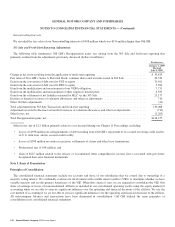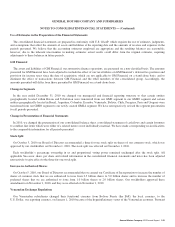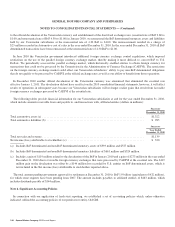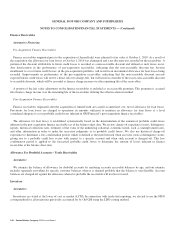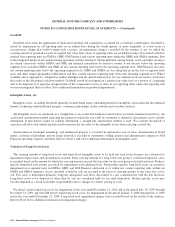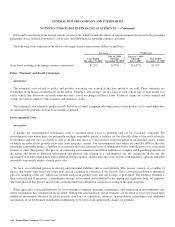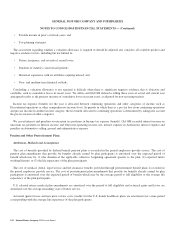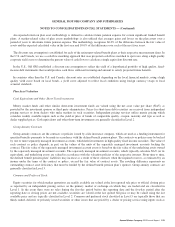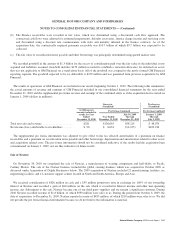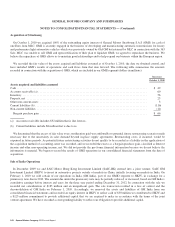General Motors 2010 Annual Report Download - page 154
Download and view the complete annual report
Please find page 154 of the 2010 General Motors annual report below. You can navigate through the pages in the report by either clicking on the pages listed below, or by using the keyword search tool below to find specific information within the annual report.GENERAL MOTORS COMPANY AND SUBSIDIARIES
NOTES TO CONSOLIDATED FINANCIAL STATEMENTS — (Continued)
considered its ability and intent to hold the investment for a sufficient period of time to allow for any anticipated recovery. If losses
are determined to be other than temporary, the loss is recorded in Interest income and other non-operating income, net and the
investment carrying amount is adjusted to a revised fair value.
Derivative Instruments
We are party to a variety of foreign currency exchange rate, interest rate swap, interest rate cap and commodity derivative contracts
entered into in connection with the management of exposure to fluctuations in foreign currency exchange rates, interest rates and
certain commodity prices.
Our financial risk management program is under the responsibility of the Risk Management Committee, which reviews and, where
appropriate, approves strategies to be pursued to mitigate these risks. The Risk Management Committee is composed of members of
our management and functions under the oversight of the Finance and Risk Committee, a committee of the Board of Directors. The
Finance and Risk Committee assists and guides the Board in its oversight of our financial and risk management strategies. A risk
management control framework is utilized to monitor the strategies, risks and related hedge positions, in accordance with the policies
and procedures approved by the Risk Management Committee.
In August 2010 we changed our automotive operations risk management policy with respect to foreign exchange and commodities.
Under our prior policy we intended to reduce volatility of forecasted cash flows primarily through the use of forward contracts and
swaps. The intent of the new policy is to protect against risk arising from extreme adverse market movements on our key exposures
and involves a shift to greater use of purchased options.
GM Financial is exposed to market risks arising from adverse changes in interest rates due to floating interest rate exposure on its
credit facilities and on certain securitization notes payable. GM Financial’s special purpose entities (SPEs) are contractually required
to purchase derivative instruments as credit enhancements in connection with securitization transactions and credit facilities. These
financial exposures and contractual requirements are managed in accordance with corporate policies and procedures and a risk
management control system is used to assist in monitoring hedging programs, derivative positions and hedging strategies. Hedging
documentation includes hedging objectives, practices and procedures and the related accounting treatment.
The accounting for changes in the fair value of each derivative financial instrument depends on whether it has been designated and
qualifies as an accounting hedge, as well as the type of hedging relationship identified. Derivative financial instruments entered into
by our automotive operations are not designated in hedging relationships. Certain of the derivatives entered into by GM Financial
have been designated in cash flow hedging relationships. Derivatives that receive hedge accounting treatment are evaluated for
effectiveness at the time they are designated as well as throughout the hedging period. We do not hold derivative financial instruments
for speculative purposes.
All derivatives are recorded at fair value and presented gross in the consolidated balance sheets. Internal models are used to value a
majority of derivatives. The models use, as their basis, readily observable market inputs, such as time value, forward interest rates,
volatility factors, and current and forward market prices for commodities and foreign currency exchange rates. Derivative contracts
that are valued based upon models with significant unobservable market inputs, primarily estimated forward and prepayment rates, are
classified in Level 3.
The valuation of derivative liabilities takes into account our nonperformance risk. At December 31, 2010 and 2009 our
nonperformance risk was not observable through a liquid credit default swap market. Our nonperformance risk was estimated using
internal analysis to develop conclusions on our implied credit rating, which we used to determine the appropriate credit spread, which
would be applied to us by market participants. Prior to receiving published credit ratings we developed our credit rating conclusions
using an analysis of comparable industrial companies. At December 31, 2010 we incorporated published credit agency ratings of GM
into our credit rating conclusions. At December 31, 2009 all derivatives whose fair values contained a significant credit adjustment
based on our nonperformance risk were classified in Level 3. At December 31, 2010 we have determined that our non-performance
152 General Motors Company 2010 Annual Report


